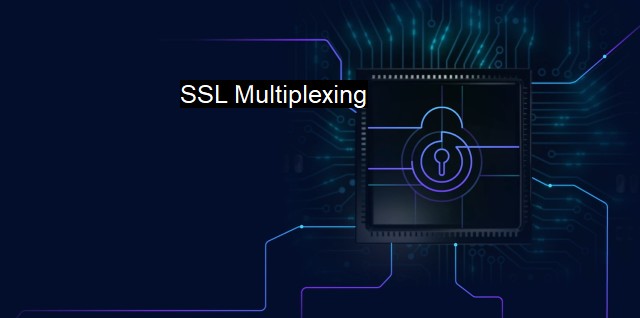What is SSL Multiplexing?
Optimizing Secure Communication: An Overview of SSL Multiplexing and Its Benefits in Performance, Security, and Reliability
SSL Multiplexing is a critical concept used within the domain of cybersecurity, commonly implemented in antivirus solutions and cybersecurity strategies. To understand the significance of SSL Multiplexing, it's necessary to first understand the purpose and function of SSL, or Secure Sockets Layer technology.SSL is a standard, globally-recognized safety technology initiated to enable a safe connection between two systems. It creates an encrypted bridge between a web server and a user, avoiding interception or tampering of data by attackers during data transmission. Upon its introduction, SSL instantly became an essential security element in an expansive range of online activities starting with e-commerce transactions to online banking, or any online service that requires personal, sensitive information from users, such as usernames, passwords, credit card numbers, etc., to function.
Multiplexing, on the other hand, is a method used in networking for combining multiple data streams into one channel over a communication link. The main purpose of multiplexing is to allow the efficient and secure management of network connections without dealing with congestion.
When SSL and multiplexing combine, they produce a strategy known as SSL Multiplexing. SSL Multiplexing is a sophisticated mechanism that involves creating a single, secure SSL connection to handle multiple user inquiries – a process essential for ensuring secure and efficient web traffic.
SSL Multiplexing is greatly valued given its ability to secure large amounts of data transmission and ensure efficiency without compromising security. Take antivirus solutions as an example. Typically, antivirus software continuously communicates with the vendor server to verify potentially harmful elements and files needing updates. It implies inbound and outbound data traffic. More the communication, more significant the impact on the network speed.
SSL Multiplexing addresses this issue by enabling multiple interactions over a single secure SSL channel rather than creating a new channel for each communication. This ensures SSL encryption to every conversation while also maintaining a high speed of the network, a balance that gets hard to achieve with increasing online threats and evolved network hacking tactics.
SSL Multiplexing contributes immensely to lowering network workload by effectively reducing the number of active connections, thus preserving the memory. Subsequently, fewer SSL handshakes mean fewer CPU resources utilized, resulting in optimized performance.
Moreover SSL Multiplexing enhances security since all communications appear as a single connection, making it difficult for adversaries to single out individual data streams. In the end, facilitating impenetrable data encryption without posing burdens on the network bandwidth, and enhancing overall user experience by maintaining data transmission speed.
Despite its profound benefits, SSL Multiplexing by no means replaces comprehensive cybersecurity solutions and antivirus software. It is an added layer that boosts the security apparatus of systems, making them more resistant to cyber threats. Critical to an organization's defense strategy, SSL Multiplexing is instrumental in optimizing resources.
SSL Multiplexing presents a double-themed advantage to cybersecurity. Its model of minimizing computing resources while maximizing encryption creates an effective and efficient environment for secure and fast data transmission. It is such uniqueness that positions SSL Multiplexing as an uncompromisable component within the realm of cyber defense. Ninety percent of internet powerhouses, such as major shopping websites and banking portals, trust SSL for a reason; the addition of multiplexing only strengthens this trust.

SSL Multiplexing FAQs
What is SSL multiplexing?
SSL multiplexing is a technique that allows multiple SSL-encrypted connections to share a single SSL connection between a client and a server. This process enables efficient and effective use of resources while still providing the necessary security measures.How does SSL multiplexing enhance cybersecurity?
SSL multiplexing enhances cybersecurity by optimizing the use of resources, allowing encrypted connections to share a single SSL connection without compromising security measures. It also reduces the attack surface by limiting the number of connections a server must maintain.Can SSL multiplexing impact antivirus operations?
Yes, it can impact antivirus operations because SSL multiplexing can prevent antivirus software from inspecting encrypted traffic. This can lead to security vulnerabilities and the potential for malware to bypass detection, making it crucial to ensure that antivirus software is SSL decryption capable.What are some challenges of implementing SSL multiplexing?
Some challenges of implementing SSL multiplexing include complexity, compatibility, and performance issues. It may require additional configuration, which can take time and resources to set up correctly. Also, SSL multiplexing can introduce new compatibility issues between different systems, which may need to be addressed to ensure optimal performance.| | A | | | B | | | C | | | D | | | E | | | F | | | G | | | H | | | I | | | J | | | K | | | L | | | M | |
| | N | | | O | | | P | | | Q | | | R | | | S | | | T | | | U | | | V | | | W | | | X | | | Y | | | Z | |
| | 1 | | | 2 | | | 3 | | | 4 | | | 7 | | | 8 | | |||||||